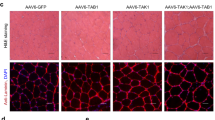Abstract
Motor neurons are known to affect muscle growth and fiber type profile (fast/slow, oxidative/glycolytic) by regulating muscle gene expression. However, the mechanism by which the information contained in specific action potential patterns is decoded by the transcriptional machinery of muscle fiber nuclei remains to be established. This is a basic issue in nerve/muscle biology, which has major implications in neurology, sport medicine and aging. We describe here a general strategy aimed at identifying the signal transduction pathways mediating the effects of nerve activity. This approach is based on the overexpression of constitutively active or dominant negative transduction factors in regenerating skeletal muscle.
Similar content being viewed by others
Author information
Authors and Affiliations
Rights and permissions
About this article
Cite this article
Schiaffino, S., Murgia, M., Serrano, A. et al. How is muscle phenotype controlled by nerve activity?. Ital J Neurol Sci 20, 409–412 (1999). https://doi.org/10.1007/s100720050060
Issue Date:
DOI: https://doi.org/10.1007/s100720050060




